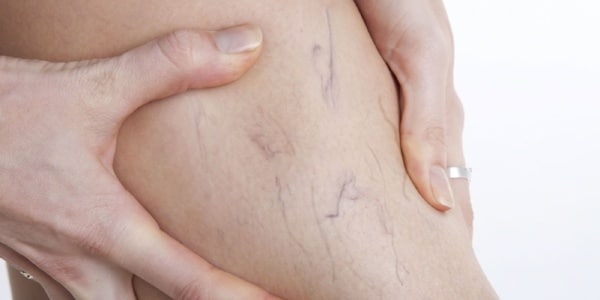
8 Common Myths About Spider Veins
There are a lot of myths and misconceptions when it comes to spider veins. So we asked Jilanne Rose, DPN, ANP-C, a top Metro Phoenix Vein Specialist, to dispel some of the more frequent misconceptions surrounding the cause, risk factors, and treatment of this common vein condition.
Myth #1: Spider Veins are Only Cosmetic
Many people believe that spider veins are unsightly but do not require treatment. Often times, there is underlying venous disease that is a much greater issue.
Myth #2: Spider Veins are Just Part of Getting Older
Although age is one of the risk factors of varicose and spider veins, it’s not the only one and is definitely not the most frequent one. The primary cause of any vein disease is hereditary. In other words, ladies and gentleman, if your mom or grandmother had varicose or spider veins, you are more likely to have them and your age is no longer relevant. In fact, vein disease can start to develop as early as your 20s, and if left untreated, varicose and spider veins will be a natural consequence. Other risk factors include female gender, pregnancy, sedentary lifestyle, being overweight, and having a history of prior leg trauma.
Myth #3: Spider Veins are Strictly a Problem for Women
Incorrect! Spider veins can happen to anyone. It is estimated that as many as 45% of all men will develop some form of venous disease by the time they reach their 60s. The number one cause of varicose veins in both men and women is family history. Lifestyle factors play a significant role as well. If your occupation requires you to stand for long periods, such as medical professionals, factory workers, first responders, sales or restaurant staff, you are more likely to get varicose veins. If you travel and spend long hours flying or driving, or if you sit at a desk for several hours at a time, you are at high risk as well.
Myth #4: Running or Standing Can Cause Spider Veins
Again, this is incorrect. In fact, running, walking or exercise is good for your veins and helps increase circulation. Prolonged standing and sitting in one position does aggravate venous disease and you will notice it more.
Myth #5: Only Overweight People get Spider Veins
Although weight may be a risk factor, a 2015 research article published in Phlebology could not directly link obesity with vein disease, so we can’t really bust that myth. Maintaining a healthy weight and lifestyle can help ease symptoms.
Myth #6: Surgery is the Only Option to Treat Spider Veins
Treatments for venous disease have taken huge leaps forward. Today, there is a range of minimally invasive, maximally effective procedures that can have you back on your feet with a much improved quality of life in very little time. Many of these procedures can be performed in a clinic, on an out-patient basis, with local anesthetic. More often than not, spider veins are treated with non-invasive or minimally invasive techniques that are nearly pain-free.
Myth #7: Vein Treatment is Painful
There was a time when leg vein surgery only referred to procedures such as vein stripping and ligations, painful procedures, likely involving general anesthetic, and definitely involving long and difficult recovery times. There are several modern procedures for varicose veins, spider veins, venous insufficiency and other vascular disease, which, cause minimal pain (if any) and have very fast recovery times. Watch this video from Jilanne Rose to learn more about what you can expect in terms of pain and recovery time .
Myth #8: Vein Treatment is Expensive and Not Covered by Insurance
Many people mistakenly believe that varicose and spider veins are only a cosmetic issue. In reality, the majority of our patients, typically have complaints that indicate an underlying venous condition such as leg pain and/or swelling, restless legs or numbing, tired legs, and leg ulcers. These are real medical problems that significantly impair activities of daily living.
After a full vein exam and ultrasound, patients find that commercial insurance carriers almost always cover vein treatment. Medicare and Medicaid will also cover vein treatment.
Additionally, the latest techniques in Sclerotherapy and Thermal Ablation, are minimally invasive and the costs are considerably lower than what you previously had to pay for a surgery.
It is best to get a complete vein exam and consultation from a qualified vein specialist in order to fully understand your specific circumstances. If you would like to find out if you are at risk of venous insufficiency in the Scottsdale, Phoenix, Mesa or Tempe area, click on the link below to book an appointment.
DVT and Varicose Veins during Pregnancy Pregnancy is a risk factor for the development of a blood clots with an incidence that is 4 to 50 times higher compared to non-pregnant women. Increased risk for development of a blood clot is highest in the postpartum period, with the most common occurrence of clot formation in…
Read MoreDeep Vein Thrombosis and Travel Ready to enjoy some summer time travel? Make sure your trip is not shortened by a serious health concern. Small, cramped seating on an airplane, or sitting in a car for a prolonged period of time, may be more of a problem that just causing discomfort. Inactivity in a confined…
Read MoreIn the second of this educational video series, Jilanne Rose talks about the pain involved in various Varicose Vein Treatments. In some cases it’s negligible! Transcript The ease with which we can eliminate varicose veins depends solely on what type of underlying problems you have. That question can’t be easily answered until after a thorough…
Read MoreWhat is Restless Leg Syndrome Restless leg syndrome (RLS), also called Willis-Ekbom disease (WED), is a common sleep-related movement disorder characterized by an unpleasant urge to move the legs. Symptoms often occur during periods of inactivity; particularly in the evenings. This urge to move is sometimes relieved by moving ones legs. During sleep, most patients’…
Read MoreOur own Dr. Jilanne Rose answers questions on Varicose Veins, Spider Veins, Vein Treatments and Insurance Coverage for Vein Treatment in Arizona. Jilanne is a true Varicose Vein Specialist as she has years of education and has been trained by the top experts in the field. She has performed over 10,000 vein care procedures herself. This is one…
Read MoreRisks of Deep Vein Thrombosis Deep Vein Thrombosis (DVT), also referred to as Deep Venous Thrombosis, is a blood clot located within a deep vein, usually in the leg. A blood clot that breaks free and travels up to the heart or lungs is referred to as a Pulmonary Embolism (PE), which can stop blood…
Read MoreWhat Causes Spider Veins? For many people who suffer from spider veins, one of their biggest questions is “What causes spider veins?” Spider Veins, also known as telangiectasia, are small veins located just under the surface of the skin. Most often found on the leg, they can either be very small and hardly noticeable, or…
Read MoreAre varicose veins covered by insurance? The answer is YES, varicose vein treatment is covered by most commercial insurance carriers such as Blue Cross Blue Shield, Champus, Aetna, Cigna, Humana, Health Net, Tricare, UMR, and UnitedHealthCare to name a few. Medicare and AHCCCS will also cover treatment. Many people only try home treatment for varicose veins…
Read MoreAre all vein clinics created equal? No they are not! Med Spa – You can turn on the television or radio at any time of the day and hear countless advertisements for “quick” or “painless” vein treatments. Go to this clinic or that medspa, and they assure you that your legs will look great in no…
Read MoreAside from conservative therapies for vein insufficiency, when your symptoms get to the point that these no longer work, or you want a more permanent solution, there are several methods to treat vein disease. All of them, regardless of method, aim to improve circulation and minimize symptoms by eliminating the abnormal vein. These methods include…
Read More




